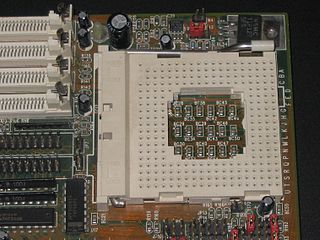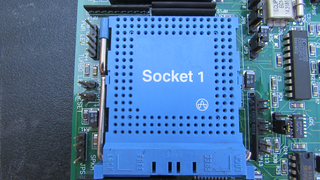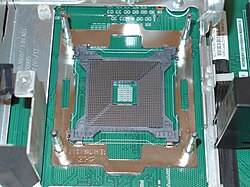
Itanium is a discontinued family of 64-bit Intel microprocessors that implement the Intel Itanium architecture. Launched in June 2001, Intel marketed the processors for enterprise servers and high-performance computing systems. The Itanium architecture originated at Hewlett-Packard (HP), and was later jointly developed by HP and Intel.

Socket 7 is a physical and electrical specification for an x86-style CPU socket on a personal computer motherboard. It was released in June 1995. The socket supersedes the earlier Socket 5, and accepts P5 Pentium microprocessors manufactured by Intel, as well as compatibles made by Cyrix/IBM, AMD, IDT and others. Socket 7 was the only socket that supported a wide range of CPUs from different manufacturers and a wide range of speeds.

Xeon is a brand of x86 microprocessors designed, manufactured, and marketed by Intel, targeted at the non-consumer workstation, server, and embedded system markets. It was introduced in June 1998. Xeon processors are based on the same architecture as regular desktop-grade CPUs, but have advanced features such as support for ECC memory, higher core counts, more PCI Express lanes, support for larger amounts of RAM, larger cache memory and extra provision for enterprise-grade reliability, availability and serviceability (RAS) features responsible for handling hardware exceptions through the Machine Check Architecture. They are often capable of safely continuing execution where a normal processor cannot due to these extra RAS features, depending on the type and severity of the machine-check exception (MCE). Some also support multi-socket systems with two, four, or eight sockets through use of the Ultra Path Interconnect (UPI) bus.
The Itanium 9300 series, code-named Tukwila, is the generation of Intel's Itanium processor family following Itanium 2 and Montecito. It was released on 8 February 2010. It utilizes both multiple processor cores (multi-core) and SMT techniques. The engineers said to be working on this project were from the DEC Alpha project, specifically those who worked on the Alpha 21464 (EV8), which was focused on SMT.

In computer hardware, a CPU socket or CPU slot contains one or more mechanical components providing mechanical and electrical connections between a microprocessor and a printed circuit board (PCB). This allows for placing and replacing the central processing unit (CPU) without soldering.

Socket 478, also known as mPGA478 or mPGA478B, is a 478-contact CPU socket used for Intel's Pentium 4 and Celeron series CPUs.

Socket 3 was a series of CPU sockets for various x86 microprocessors. It was sometimes found alongside a secondary socket designed for a math coprocessor chip, such as the 487. Socket 3 resulted from Intel's creation of lower voltage microprocessors. An upgrade to Socket 2, it rearranged the pin layout. Socket 3 is compatible with 168-pin socket CPUs.

Altix is a line of server computers and supercomputers produced by Silicon Graphics, based on Intel processors. It succeeded the MIPS/IRIX-based Origin 3000 servers.
HPE Integrity is a series of server computers produced by Hewlett Packard Enterprise since 2003, based on the Itanium processor. The Integrity brand name was inherited by HP from Tandem Computers via Compaq.

Socket 479 (mPGA479M) is the CPU socket for the Intel Pentium M and Celeron M mobile processors normally used in laptops, but has also been used with Tualatin-M Pentium III processors. The official naming by Intel is µFCPGA and µPGA479M.

Socket 1, originally called the "OverDrive" socket, was the second of a series of standard CPU sockets created by Intel into which various x86 microprocessors were inserted. It was an upgrade to Intel's first standard 169-pin pin grid array (PGA) socket and the first with an official designation. Socket 1 was intended as a 486 upgrade socket, and added one extra pin to prevent upgrade chips from being inserted incorrectly.

LGA 771, also known as Socket J, is a CPU interface introduced by Intel in 2006. It is used in Intel Core microarchitecture and NetBurst microarchitecture(Dempsey) based DP-capable server processors, the Dual-Core Xeon is codenamed Dempsey, Woodcrest, and Wolfdale and the Quad-Core processors Clovertown, Harpertown, and Yorkfield-CL. It is also used for the Core 2 Extreme QX9775, and blade servers designated under Conroe-CL.

LGA 1366, also known as Socket B, is an Intel CPU socket. This socket supersedes Intel's LGA 775 in the high-end and performance desktop segments. It also replaces the server-oriented LGA 771 in the entry level and is superseded itself by LGA 2011. This socket has 1,366 protruding pins which touch contact points on the underside of the processor (CPU) and accesses up to three channels of DDR3 memory via the processor's internal memory controller.

Socket PAC418 is a 418 pin microprocessor socket designed to interface an Intel Itanium processor to the rest of the computer. It provides both an electrical interface as well as physical support. This socket is designed to support a microprocessor module.

Socket PAC611 is a 611 pin microprocessor socket designed to interface an Intel Itanium 2 processor to the rest of the computer. It provides both an electrical interface as well as physical support. This socket is designed to support a microprocessor module.
Intel Sandy Bridge-based Xeon microprocessors are microprocessors based on the Intel's 32 nm Sandy Bridge architecture for servers, workstations, and high-end desktops. It succeeds the six-core Gulftown/Westmere-EP processor which used the older LGA 1366 package, and uses LGA 2011, LGA 1356 and LGA 1155 socket depending on the package.
Socket G3, also known as rPGA 946B/947 or FCPGA 946, is a socket for Intel microprocessors that supports Haswell-based mobile CPUs. Compatible SKUs have an 'M' suffix in the model number.













